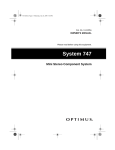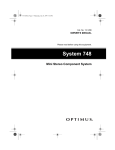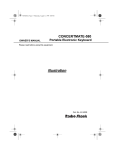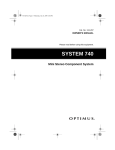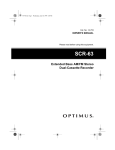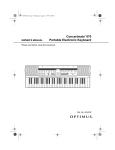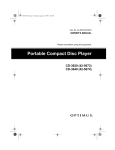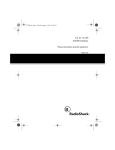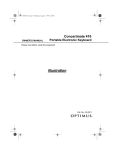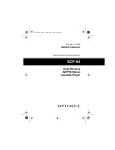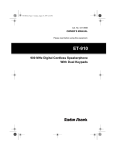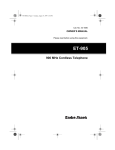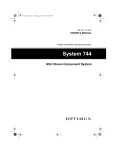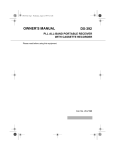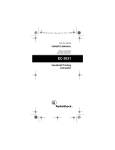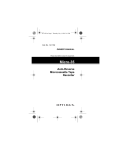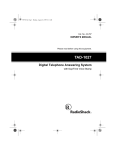Download Optimus CD-3680 (42-5075) CD Player User Manual
Transcript
42-5075.fm Page 1 Thursday, August 12, 1999 1:03 PM Cat. No. 42-5075/42-5076 OWNER’S MANUAL Please read before using this equipment. Portable Compact Disc Player with Digital Anti-Shock CD-3680 (42-5075) CD-3690 (42-5076) 42-5075.fm Page 2 Thursday, August 12, 1999 1:03 PM FEATURES Your Optimus CD-3680 (42-5075)/ CD-3690 (42-5076) Portable Compact Disc Player with Digital Anti-Shock uses the latest digital audio technology to give you the clean, crisp sound of compact discs. You can connect the CD player to your home audio or autosound system or connect a pair of stereo earphones for portable, private listening. Audible Search — lets you rapidly play a CD in either direction to locate a desired section of a track. Programmable Play — lets you program and play up to 24 tracks in any sequence you choose. Repeat Play — lets you automatically repeat a single track, an entire CD, or a programmed sequence. The CD player’s features include: Digital Anti-Shock System (DAS 2) — rapidly scans 3 seconds (42-5075) or 10 seconds (42-5076) of data from the CD and stores it in memory for uninterrupted play with no sound skip even when the CD player is exposed to shocks or vibration, making this CD player excellent for use in your vehicle. Eight-Times Oversampling with Digital Filtering — improves the CD’s sound by multiplying the standard 44.1 kHz sample rate by eight and using a digital filter to reduce or eliminate distortion. 1-Bit DAC — uses the latest in digitalto-analog conversion circuitry to accurately reproduce all sound levels with virtually no distortion. Automatic Search Music System (ASMS) — lets you quickly locate and play any track on a CD. Random Play — randomly selects and plays tracks from the loaded CD. Cue — lets you cue a track for play at a later time. Intro Scan — scans and plays the first 10 seconds of each track, so you can find a specific track. Extended Bass System — creates a fuller bass sound. Auto Power On/Off — automatically turns on the CD player when you press PLAY/PAUSE, and turns it off when you press STOP/CLEAR or 2 minutes after it finishes playing, to help preserve battery life. Hold — prevents accidentally changing the CD player’s control settings and preserves battery life by locking most controls. © 1997 Tandy Corporation. All Rights Reserved. Optimus and RadioShack are registered trademarks used by Tandy Corporation. 2 42-5075.fm Page 3 Thursday, August 12, 1999 1:03 PM Resume — lets you easily resume listening to the track that was selected when you stopped playing a CD. Three Power Sources — let you power your CD player from two standard or rechargeable nickel-cadmium AA batteries, your vehicle’s battery using the supplied DC adapter, or standard AC power using an optional AC adapter. Important: You need a pair of stereo headphones, earphones, or amplified speakers, or a home audio or autosound system to use your CD player. Your local RadioShack store carries a complete line of headphones, earphones, speakers, and audio systems. CDs that can be played on this CD player have this mark on them: Power/Charging Jack — lets you charge nickel-cadmium batteries without removing them from the CD player. Lighted Buttons and Display — when you operate the CD player with an AC or DC adapter, the buttons and display light up for easy viewing in the dark. Supplied CD-to-Cassette Adapter — lets you connect the CD player directly to a cassette player in your home or vehicle. Line Out Jack and Supplied YCable — makes it easy to connect the CD player to your sound system’s lowlevel inputs. The CD player’s advanced technology makes it simple to operate. But, be sure you read this Owner’s Manual completely so you can take advantage of all its advanced features. We recommend you record your CD player’s serial number here. The number is inside the CD player’s battery compartment. Serial Number __________________ 5- or 3-Inch CD Compatible Carrying Pouch (Supplied with 425076 only) 3 42-5075.fm Page 4 Thursday, August 12, 1999 1:03 PM This CD player is made and tested to meet exacting safety standards. It meets FCC requirements and complies with safety performance standards of the U.S. Department of Health and Human Services. Warnings: • This CD player employs a laser light beam. Only a qualified service person should remove the cover or attempt to service this device, due to possible eye injury. • The use of controls, adjustments, or procedures other than those specified herein might result in hazardous radiation exposure. FCC INFORMATION This equipment complies with the limits for a Class B digital device as specified in Part 15 of FCC Rules. These limits provide reasonable protection against radio and TV interference in a residential area. However, your CD player might cause TV or radio interference even when it is operating properly. To eliminate interference, you can try one or more of the following corrective measures: • Increase the distance between the CD player and the radio or TV. • Use outlets on different electrical circuits for the CD player and the radio or TV. Consult your local RadioShack store if the problem still exists. 4 42-5075.fm Page 5 Thursday, August 12, 1999 1:03 PM CONTENTS Powering the CD Player ...................................................................................... Using Batteries ................................................................................................ Recharging Nickel-Cadmium Batteries ..................................................... Using Vehicle Battery Power ........................................................................... Using AC Power .............................................................................................. 6 6 7 8 8 Connections ....................................................................................................... Connecting Earphones/Headphones ............................................................ Listening Safely ...................................................................................... Traffic Safety ........................................................................................... Connecting Amplified Speakers .................................................................... Connecting to a Home Audio System ........................................................... Connecting to an Autosound System ............................................................ 10 10 10 10 11 11 11 Operation ............................................................................................................ Loading a CD ................................................................................................ Playing a CD ................................................................................................. Digital Anti-Shock System (DAS 2) ................................................................ Automatic Search Music System (ASMS) ..................................................... Locking the Controls ..................................................................................... Viewing the Elapsed Time ............................................................................. Turning E-Bass On and Off ........................................................................... Audible Search .............................................................................................. Pause/Cue .................................................................................................... Intro Scan ...................................................................................................... Repeat Play .................................................................................................. Random Play ................................................................................................ Programmed Play ......................................................................................... Resume ......................................................................................................... 13 13 13 14 14 15 15 15 16 16 16 16 17 17 18 Troubleshooting ................................................................................................ 19 Care and Maintenance ...................................................................................... 20 Replacing the DC Adapter’s Fuse ................................................................. 21 CD Care Tips ................................................................................................ 21 Specifications .................................................................................................... 22 5 42-5075.fm Page 6 Thursday, August 12, 1999 1:03 PM POWERING THE CD PLAYER You can power your CD player from any of these sources: • Two AA alkaline batteries (not supplied) • Two rechargeable AA nickelcadmium batteries (not supplied) • Vehicle battery power using the supplied DC adapter • Standard AC power using an AC adapter (not supplied) Note: Connecting an AC or DC adapter to the CD player with non-rechargeable batteries installed disconnects the batteries. USING BATTERIES You can power your CD player from two AA alkaline batteries (such as RadioShack Cat. No. 23-552) or two rechargeable AA nickel-cadmium batteries (such as Cat. No. 23-125). Cautions: • Always use fresh, or freshly charged, batteries of the required size and type. • Do not mix old and new batteries, different types of batteries (standard, alkaline, or rechargeable nickel-cadmium), or rechargeable batteries of different capacities. Follow these steps to install the batteries. 6 1. Press down on the battery compartment cover and slide it in the direction of the arrow on the cover, then lift the cover. Caution: The battery compartment cover is attached to the CD player. Do not try to remove it. 2. Put two AA alkaline batteries or two AA nickel-cadmium batteries in the battery compartment, as indicated by the polarity symbols (+ and –) marked inside. Note: Before you use the CD player with nickel-cadmium batteries, you need to charge them, either in an external battery charger (such as Cat. No. 23-134) or in the CD player (see “Recharging Nickel-Cadmium Batteries” on Page 7). 3. Close the battery compartment cover. If flashes on the display, the sound distorts, or the volume weakens, replace or recharge the batteries. 42-5075.fm Page 7 Thursday, August 12, 1999 1:03 PM Cautions: • If you will not be using the CD player with battery power for several months, remove the batteries. • Dispose of old batteries promptly and properly. Recharging Nickel-Cadmium Batteries If you connect the supplied DC adapter (see “Using Vehicle Battery Power” on Page 8) or an AC adapter (see “Using AC Power” on Page 8) to the CD player, you can set the CD player to charge nickel-cadmium batteries while they are inside the CD player’s battery compartment. Cautions: • Use only the supplied DC adapter or an AC adapter that meets the specifications in “Using AC Power” on Page 8 to recharge the batteries in the CD player. Other adapters could damage your CD player or the batteries. • Do not use the CD player or open the CD compartment cover while you are charging nickel-cadmium batteries. Follow these steps to charge nickelcadmium batteries in the CD player. 1. Connect an AC adapter or the supplied DC adapter to your CD player (see “Using AC Power” on Page 8 or “Using Vehicle Battery Power” on Page 8). 2. With rechargeable batteries installed and the CD compartment cover closed, press STOP/CLEAR. CHG flashes on the display. Then CHG CHG CHG appears and the CD player starts to recharge the batteries. It takes about 3 hours to charge new or fully discharged nickelcadmium batteries. Subsequent charges take 2–3 hours. 3. When the batteries are fully charged, the CD player automatically stops charging them and turns itself off. Disconnect the AC or DC adapter. • Nickel-cadmium batteries charge more efficiently if the temperature is above 40°F (4.5°C) and below 90°F (32°C). 7 42-5075.fm Page 8 Thursday, August 12, 1999 1:03 PM Important: Your CD player is capable of using nickel-cadmium batteries. At the end of the batteries’ useful life, they must be recycled or disposed of properly. Contact your local, county, or state hazardous waste management authorities for information on recycling or disposal programs in your area. Some options that might be available are: municipal curbside collection, drop-off boxes at retailers such as your local RadioShack store, recycling collection centers, and mailback programs. USING VEHICLE BATTERY POWER You can power your CD player from your vehicle’s cigarette-lighter socket with the supplied DC adapter. Cautions: • The supplied DC adapter supplies 6 volts and delivers at least 500 milliamps. Its center tip is set to positive, and its plug correctly fits the CD player’s DC IN 6V jack. Using a DC adapter that does not meet these specifications could damage the CD player or the DC adapter. • When you finish using the CD player, always unplug the DC adapter from the cigarette-lighter socket before you disconnect it from your CD player. 8 Follow these steps to connect the cigarette-lighter socket to the CD player. 1. Insert the DC adapter’s barrel plug into the CD player’s DC IN 6V jack. 2. Make sure the DC adapter’s tip is securely attached, then plug the DC adapter’s other end into your vehicle’s cigarette-lighter socket. Note: If the CD player does not operate when you use the DC adapter, unplug the cord from the cigarette-lighter socket and clean any ashes or debris from the socket. USING AC POWER You can power the CD player from a standard AC outlet using an optional AC adapter such as Cat. No. 2731664. Cautions: • You must use an AC adapter that supplies 6 volts and delivers at least 500 milliamps. Its center tip must be set to positive, and its plug must correctly fit the CD player’s DC IN 6V jack. The recom- 42-5075.fm Page 9 Thursday, August 12, 1999 1:03 PM mended adapter meets these specifications. Using an adapter that does not meet these specifications could damage the CD player or the adapter. • When you finish using the AC adapter, unplug it from the AC outlet first, then disconnect it from the CD player. Follow these steps to connect the CD player to AC power. 1. Insert the AC adapter’s 4.0 mm outer diameter/1.7 mm inner diameter barrel plug into the adapter’s cord, setting TIP to + (positive). 2. Set the AC adapter’s voltage switch to 6V. 3. Insert the AC adapter’s barrel plug into the CD player’s DC IN 6V jack. 4. Plug the other end of the adapter into a standard AC outlet. 9 42-5075.fm Page 10 Thursday, August 12, 1999 1:03 PM CONNECTIONS You can listen to your CD player by connecting earphones/headphones or amplified speakers to the player’s PHONES jack, or by connecting a home audio or autosound system to the CD player’s LINE OUT jack. Note: If the jacks on your equipment do not match the plugs on the supplied Y-cable, check with your local RadioShack store for the proper cable adapter. CONNECTING EARPHONES/ HEADPHONES For private listening, you can plug a pair of stereo earphones or headphones with a 1/8-inch plug (not supplied) into the PHONES jack on the CD player. Listening Safely To protect your hearing, follow these guidelines when you use earphones or headphones. • Set the volume to the lowest setting before you begin listening. After you begin listening, adjust the volume to a comfortable level. • Do not volume volume manent listen at extremely high levels. Extended highlistening can lead to perhearing loss. • Once you set the volume, do not increase it. Over time, your ears adapt to the volume level, so a volume level that does not cause discomfort might still damage your hearing. Traffic Safety Do not wear earphones or headphones while operating a motor vehicle or riding a bicycle. This can create a traffic hazard and could be illegal in some areas. Even though some earphones and headphones let you hear some outside sounds when listening at normal volume levels, they still can present a traffic hazard. 10 42-5075.fm Page 11 Thursday, August 12, 1999 1:03 PM CONNECTING AMPLIFIED SPEAKERS CONNECTING TO AN AUTOSOUND SYSTEM You can listen to your CD player through optional amplified speakers (such as Cat. No. 40-1387). Plug the speaker cable’s 1/8-inch plug into the CD player’s PHONES jack. You can listen to your CD player through your autosound system in one of the following ways: • If your autosound system has LINE IN jacks, connect the supplied Y-cable’s 1/8-inch plug to the CD player’s LINE OUT jack. Then connect the Y-cable’s phono plugs to your autosound system’s LINE IN input jacks. CONNECTING TO A HOME AUDIO SYSTEM You can listen to your CD player through your home audio system’s amplifier/receiver and full-size speakers. Connect the supplied Y-cable’s 1/8-inch plug to the CD player’s LINE OUT jack. Then connect the Y-cable’s phono plugs to your audio system’s left and right CD, AUX, or TV audio input jacks. • If your autosound system has a CD input jack, connect one end of a 1/8-inch stereo patch cable (such as Cat. No. 42-2387, not supplied) to the CD player’s LINE OUT jack. Then connect the other end to your autosound system’s CD INPUT jack. 11 42-5075.fm Page 12 Thursday, August 12, 1999 1:03 PM • If your autosound system has a cassette deck, connect the supplied CD-to-cassette adapter’s plug to the CD player’s PHONES jack. Then insert the adapter’s other end into your cassette deck just like a standard cassette. Note: You can mount your CD player in your car using an optional mounting bracket. Your local RadioShack store has a complete line of mounting brackets and hardware. 12 42-5075.fm Page 13 Thursday, August 12, 1999 1:03 PM OPERATION LOADING A CD PLAYING A CD Caution: To help prevent dust from entering the CD player, always keep the CD compartment cover closed except when loading or unloading CDs. Warning: To protect your hearing if you are using earphones or headphones, set VOLUME to its lowest setting before you play a CD. 1. Set OFF/RESUME/HOLD to OFF. Press PLAY/PAUSE. The CD player automatically turns on and 00 briefly flashes on the display. Then and the current track number appear and Track 1 begins to play. 2. Slide OPEN in the direction of the arrow and lift the CD compartment cover. If you connected an earphone/headphones or amplified speakers to the CD player’s PHONES jack, use VOLUME on the CD player to adjust the volume. 3. Carefully place a CD, label side up, over the center hub inside the CD compartment. Then gently press the center of the CD until it snaps down onto the center hub. Center Hub If you connected the CD player to your home audio system or autosound system using the LINE OUT jack, you must use the home audio or autosound system’s volume control to adjust the volume. 4. Close the compartment cover. 13 42-5075.fm Page 14 Thursday, August 12, 1999 1:03 PM If you connected an external power source, the CD player’s buttons light until you stop the CD and turn the CD player off, or the CD player turns itself off automatically. To turn on the anti-shock system, set DAS OUT/IN to IN. If the CD player is playing a CD, the sound briefly stops, then appears on the display and the sound continues. To temporarily stop play, press PLAY/ flashes. To resume play, press PLAY/PAUSE again. PAUSE . When the last track finishes playing, the CD stops and the display alternately shows the total number of tracks and total playing time of the CD for about 2 minutes, then the CD player automatically turns off. To turn it off sooner, press STOP/CLEAR. DIGITAL ANTI-SHOCK SYSTEM (DAS2) Your CD player contains special circuits to overcome sound skipping problems caused by shock or vibration. This means you can carry the CD player anywhere you go or use it in your vehicle. When you turn on the anti-shock system, the CD player continuously saves 3 seconds (42-5075) or 10 seconds (42-5076) of music in memory. During a shock or vibration that would normally make a track skip or pause, the CD player plays directly from memory. 14 AUTOMATIC SEARCH MUSIC SYSTEM (ASMS) You can use ASMS before or during regular or programmed play (see “Programmed Play” on Page 17) to quickly locate any track on a CD. While the CD is stopped, repeatedly press or to move backward or forward to the desired track. Press PLAY/PAUSE to play the track. During play, press to return to the beginning of the current track. Press twice to return to the beginning of the previous track. To move to the beginning of the next track, press . Note: The CD player consumes additional battery power when you use the anti-shock system. When you use the CD player in a stable location, set DAS OUT/IN to OUT to save battery power. 42-5075.fm Page 15 Thursday, August 12, 1999 1:03 PM To turn off the anti-shock system, set DAS OUT/IN to OUT. The sound briefly stops, then disappears from the display. LOCKING THE CONTROLS VIEWING THE ELAPSED TIME To display the current track’s elapsed time, hold down MEMORY/E-BASS for about 1 second. Hold down MEMORY/ E-BASS again to return to the current track display. You can protect your CD player from accidental program changes by locking all controls except OPEN, VOLUME , DAS OUT/IN (and OFF/RESUME/ HOLD itself). To turn on the control lock, set OFF/ RESUME/HOLD to HOLD. To turn it off, set OFF/RESUME/HOLD to OFF. TURNING E-BASS ON AND OFF To enhance the bass sound, press MEMORY/E-BASS. appears on the display. To turn the bass sound off, press MEMORY/E-BASS again. disappears from the display. 15 42-5075.fm Page 16 Thursday, August 12, 1999 1:03 PM AUDIBLE SEARCH INTRO SCAN To search forward or backward during . The CD play, hold down or plays rapidly and you hear the music at a high speed and low volume. The current track’s elapsed time appears on the display. You can set the stereo to play the first 10 seconds of each track on the CD, so you can find the track you want to listen to. Release the button to resume normal play. Note: If you hold down while the last track is playing, audible search starts again at the beginning of that same track. If you hold down during the first track, audible search stops at the beginning of Track 1. To begin scanning, repeatedly press PLAY MODE until appears on the display. Intro scan starts from the first track. To return to normal play, repeatedly press PLAY MODE until disappears. Notes: • Intro scan plays the tracks in the programmed order if you have programmed a sequence (see “Programmed Play” on Page 17). • You can use and skip through the tracks. to PAUSE/CUE REPEAT PLAY To temporarily pause play, press PLAY/PAUSE . flashes on the display. Press PLAY/PAUSE again to resume play. You can repeat a single track on the CD, all tracks on the CD, or a programmed sequence (see “Programmed Play” on Page 17). You can also use PLAY/PAUSE to select (cue) a track before playing. When the CD player is stopped, press or to select the track you want to cue. Then press PLAY/ PAUSE twice. flashes. When you are ready to play the track, press PLAY/PAUSE again. To repeat a single track, press PLAY MODE once while the desired track is 16 playing. appears on the display, and the CD player continuously replays the track. 42-5075.fm Page 17 Thursday, August 12, 1999 1:03 PM To cancel random play, repeatedly press PLAY MODE until disappears. PROGRAMMED PLAY To repeat all tracks on a CD or in a programmed sequence, press PLAY MODE twice. appears on the display. You can program up to 24 tracks from the loaded CD to play in any order you choose, and you can program the same track to play more than once. Follow these steps to program and play a sequence. When the CD player reaches the end of the CD or the programmed sequence, it continuously returns to the first track and replays all the tracks. To cancel repeat play, repeatedly press PLAY MODE until and disappear, RANDOM PLAY In random play, the CD player plays all the tracks once in random order, then automatically stops. To start random play, repeatedly press PLAY MODE until appears on the display. Note: If you select random play during programmed play, the CD player stops the programmed sequence and starts random play of all tracks. 1. While the CD is stopped, hold down MEMORY/E-BASS for about 3 seconds. The display shows the selection number (01) and the track number (00), and flashes. 2. Repeatedly press either or to display the number of the first track you want to program. 3. Press MEMORY/E-BASS to store the selected track number. The selection number advances by one and the track number returns to 00. 4. Repeat Steps 2 and 3 for each track you want to program, up to 24 tracks. Note: When you store the 24th track in memory, FuLL appears. 5. To play the programmed sequence, press PLAY/PAUSE. lights and the first track in the sequence plays. 17 42-5075.fm Page 18 Thursday, August 12, 1999 1:03 PM While the programmed sequence plays, you can use to move forward or to move backward in the sequence. 6. After the last programmed track ends, the CD player stops. To stop the CD before the end of the sequence, press STOP/CLEAR. Note: You can replay, check, or add to the programmed sequence within 2 minutes after play stops. Otherwise, the CD player turns off and clears the programmed sequence. • To replay the programmed sequence, press PLAY/PAUSE. • To check the programmed sequence, press MEMORY/E-BASS. The display shows the number of the first programmed track. Each time you press MEMORY/E-BASS, the display shows the number of the next track in the sequence. • To add to the end of a programmed sequence , repeatedly press MEMORY/E-BASS until track number 00 appears. Then follow Steps 3 and 4. To clear the programmed sequence from memory, press STOP/CLEAR twice or open the CD compartment door. 18 RESUME You can set the CD player to remember the track it was playing when you stopped the CD or it turned itself off. That way, when you play the CD again, the CD player resumes playing at the beginning of that track. To set the CD player to resume, set OFF/RESUME/HOLD to RESUME at any time. Then, after you have pressed STOP/CLEAR to turn off the CD player, you can simply press PLAY/PAUSE to resume play. To cancel resume play, set OFF/ RESUME/HOLD to OFF or open the CD compartment. Notes: • If you press STOP/CLEAR very close to the beginning or end of a track, the CD player might play the track before or after that track instead when you press PLAY/ PAUSE. This is not a malfunction. • If you install a different CD while OFF/RESUME/HOLD is set to RESUME, play might not start from Track 1 on the new CD. If this happens, press STOP/CLEAR, set OFF/RESUME/HOLD to OFF, then press PLAY/PAUSE again. 42-5075.fm Page 19 Thursday, August 12, 1999 1:03 PM TROUBLESHOOTING If you have problems operating your CD player, check this chart. If these suggestions do not solve the problem, contact your local RadioShack store for assistance. Problem The CD player does not work. Possible Cause OFF/RESUME/HOLD is set to HOLD. No power. Solution Set OFF/RESUME/HOLD to OFF. Be sure the batteries are not weak. Make sure an AC adapter or the DC adapter is properly connected. If you are using a DC adapter to power the CD player, check the adapter’s fuse. See “Replacing the DC Adapter’s Fuse” on Page 21. A CD is loaded, but the CD player does not start. The CD is loaded upside-down. Reload the CD, label side up. The CD is dirty or defective. Clean the CD and reload it, or try a different CD. See “Replacing the DC Adapter’s Fuse” on Page 21. Sound from a CD skips. The CD is dirty or defective. Clean the CD and reload it, or try a different CD. See “Replacing the DC Adapter’s Fuse” on Page 21. Vibration is excessive. Set DAS OUT/IN to IN. Place the CD player in a different location. Moisture has condensed on the pickup lens. Wait 1 hour for the moisture to evaporate. 19 42-5075.fm Page 20 Thursday, August 12, 1999 1:03 PM CARE AND MAINTENANCE Your Optimus CD-3680/CD-3690 Portable Compact Disc Player with Digital AntiShock is an example of superior design and craftsmanship. The following suggestions will help you care for your CD player so you can enjoy it for years. Keep the CD player dry. If it gets wet, wipe it dry immediately. Liquids might contain minerals that can corrode the electronic circuits. Use and store the CD player only in normal temperature environments. Temperature extremes can shorten the life of electronic devices, damage batteries, and distort or melt plastic parts. Keep the CD player away from dust and dirt, which can cause premature wear of parts. Handle the CD player gently and carefully. Dropping it can damage circuit boards and cases and can cause the CD player to work improperly. Use only fresh batteries of the required size and type. Batteries can leak chemicals that damage your CD player’s electronic parts. Wipe the CD player with a damp cloth occasionally to keep it looking new. Do not use harsh chemicals, cleaning solvents, or strong detergents to clean the CD player. Modifying or tampering with the CD player’s internal components can cause a malfunction and might invalidate your CD player’s warranty and void your FCC authorization to operate it. If your CD player is not performing as it should, take it to your local RadioShack store for assistance. 20 42-5075.fm Page 21 Thursday, August 12, 1999 1:03 PM REPLACING THE DC ADAPTER’S FUSE If the CD player stops operating, check the fuse in the DC adapter’s cigarette-lighter plug. If it has blown, follow these steps to replace it with a 3-amp, 5 × 20 mm, fast-acting fuse such as Cat. No. 270-1054 (not supplied). Caution: Using a fuse that does not meet these ratings can damage your CD player or the vehicle’s electrical system. 1. Carefully unscrew the tip of the cigarette-lighter plug. CD CARE TIPS Even though a CD is very durable, you should handle it with care. • Keep the CD inside the CD player or in its protective case or sleeve when you are not playing it. • Handle a CD by its edges to avoid fingerprints that can prevent the CD player’s laser beam from accurately reading the CD. Your local RadioShack store sells a suitable CD cleaner kit. • Do not write on either side of the CD, particularly the non-label side. (Signals are read from the non-label side.) • Keep the CD dry. A water drop can act as a lens and affect the laser beam’s focus. 2. Remove the old fuse and replace it with the new fuse. 3. Screw the cigarette-lighter plug’s tip back onto the body. • Never use chemicals such as record cleaning sprays, anti-static sprays or fluids, benzene or thinner to clean CDs. These chemicals will permanently damage the plastic surface of the CD. • If a CD skips when you try to play it, the CD might be scratched. Your local RadioShack store sells a Scratch ’n Fix kit (Cat. No. 42-127) that might stop the skip. Also see “Troubleshooting” on Page 19. 21 42-5075.fm Page 22 Thursday, August 12, 1999 1:03 PM SPECIFICATIONS AUDIO Frequency Response (±3 dB) ........................................................... 20–20,000 Hz Dynamic Range ............................................................................................. 80 dB Signal-to-Noise Ratio ..................................................................................... 80 dB Harmonic Distortion at 1 kHz ........................................................................ 0.07% Separation at 1 kHz ....................................................................................... 55 dB Wow/Flutter .................................................................................... Not Measurable Earphones Output (10% THD at 32 ohm) ......................................... 7 mW + 7 mW Line Output ..................................................................................................... 0.6 V SIGNAL FORMAT Sampling Frequency ................................................................................. 44.1 kHz Oversampling .............................................................................................. 8 Times Quantization Number ............................................................ 16-Bit Linear/Channel Transmission Bit Rate ............................................................... 4.3218 Mb/Second Signal-Processing Rate .......................................................................... 352.8 kHz PICK-UP Tracking System ....................................................... 3-Beam Tracking Servo Type Object Lens Drive System ......................................... 2-Dimensional Parallel Drive Optical Source ....................................................................... Semiconductor Laser Wavelength .................................................................................................. 780 nm GENERAL Power Requirements .................................................... DC 3V; Two AA Alkaline or Rechargeable Nickel-Cadmium Batteries (not supplied), DC Adapter (supplied) AC Adapter such as 273-1664 (not supplied), Power Consumption .......................................................................................... 8 W Battery Life (EIAJ Method) ................................................. 7 Hours (with DAS2 off) Dimensions (HWD) ........................... 11/8 × 51/16 × 53/8 Inches (32 × 129 × 137 mm) Weight (without batteries) ................................................................. 9.5 oz (270 g) Included Accessories .................................. Y-Cable, DC Adapter, CD-to-Cassette Adapter, Carrying Case (CD-3690 only) Specifications are typical; individual units might vary. Specifications are subject to change and improvement without notice. 22 42-5075.fm Page 23 Thursday, August 12, 1999 1:03 PM NOTES 23 42-5075.fm Page 24 Thursday, August 12, 1999 1:03 PM Limited One-Year Warranty This product is warranted by RadioShack against manufacturing defects in material and workmanship under normal use for one (1) year from the date of purchase from RadioShack company-owned stores and authorized RadioShack franchisees and dealers. EXCEPT AS PROVIDED HEREIN, RadioShack MAKES NO EXPRESS WARRANTIES AND ANY IMPLIED WARRANTIES, INCLUDING THOSE OF MERCHANTABILITY AND FITNESS FOR A PARTICULAR PURPOSE, ARE LIMITED IN DURATION TO THE DURATION OF THE WRITTEN LIMITED WARRANTIES CONTAINED HEREIN. EXCEPT AS PROVIDED HEREIN, RadioShack SHALL HAVE NO LIABILITY OR RESPONSIBILITY TO CUSTOMER OR ANY OTHER PERSON OR ENTITY WITH RESPECT TO ANY LIABILITY, LOSS OR DAMAGE CAUSED DIRECTLY OR INDIRECTLY BY USE OR PERFORMANCE OF THE PRODUCT OR ARISING OUT OF ANY BREACH OF THIS WARRANTY, INCLUDING, BUT NOT LIMITED TO, ANY DAMAGES RESULTING FROM INCONVENIENCE, LOSS OF TIME, DATA, PROPERTY, REVENUE, OR PROFIT OR ANY INDIRECT, SPECIAL, INCIDENTAL, OR CONSEQUENTIAL DAMAGES, EVEN IF RadioShack HAS BEEN ADVISED OF THE POSSIBILITY OF SUCH DAMAGES. Some states do not allow the limitations on how long an implied warranty lasts or the exclusion of incidental or consequential damages, so the above limitations or exclusions may not apply to you. In the event of a product defect during the warranty period, take the product and the RadioShack sales receipt as proof of purchase date to any RadioShack store. RadioShack will, at its option, unless otherwise provided by law: (a) correct the defect by product repair without charge for parts and labor; (b) replace the product with one of the same or similar design; or (c) refund the purchase price. All replaced parts and products, and products on which a refund is made, become the property of RadioShack. New or reconditioned parts and products may be used in the performance of warranty service. Repaired or replaced parts and products are warranted for the remainder of the original warranty period. You will be charged for repair or replacement of the product made after the expiration of the warranty period. This warranty does not cover: (a) damage or failure caused by or attributable to acts of God, abuse, accident, misuse, improper or abnormal usage, failure to follow instructions, improper installation or maintenance, alteration, lightning or other incidence of excess voltage or current; (b) any repairs other than those provided by a RadioShack Authorized Service Facility; (c) consumables such as fuses or batteries; (d) cosmetic damage; (e) transportation, shipping or insurance costs; or (f) costs of product removal, installation, set-up service adjustment or reinstallation. This warranty gives you specific legal rights, and you may also have other rights which vary from state to state. RadioShack Customer Relations, Dept. W, 100 Throckmorton St., Suite 600, Fort Worth, TX 76102 We Service What We Sell 3/97 RadioShack A Division of Tandy Corporation Fort Worth, Texas 76102 9A7 Printed in Thailand
























